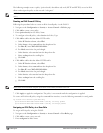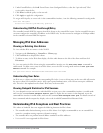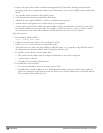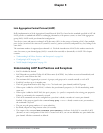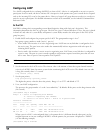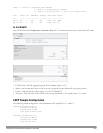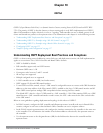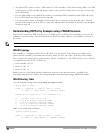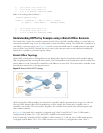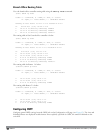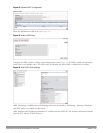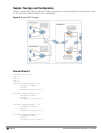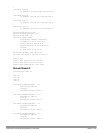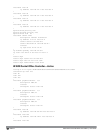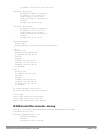
153 | OSPFv2 DellPowerConnectW-SeriesArubaOS6.2 | User Guide
l The default MTU value for a Layer 3 GRE tunnel in a Dell controller is 1100. When running OSPF over a GRE
tunnel between a Dell controller and another vendor’s router, the MTU values must be the same on both sides
of the GRE tunnel.
l Do not enable OSPF on any uplink/WAN interfaces on the Branch Office Controller. Enable OSPF only on the
Layer 3 GRE tunnel connecting the master controller.
l Use only one physical port in the uplink VLAN interface that is connecting to the upstream router. This will
prevent broadcasting the protocol PDUs to other ports and hence limit the number of adjacencies on the uplink
interface to only one.
Understanding OSPFv2 by Example using a WLAN Scenario
In the WLAN scenario, the Dell controller acts as a default gateway for all the clients and talks to one or two (for
redundancy) upstream routers. The controller advertises all the user subnet addresses as stub addresses via LSAs to
the routers..
NOTE: Totally stub areas
see
only a default route and routes local to the areas themselves.
WLAN Topology
The controller () is configured with VLAN 10 and VLAN 12 as user VLANs. These VLANs have clients on the
subnets and the controller is the default router for those clients. VLAN 4 and VLAN 5 both have OSPF enabled.
These interfaces are connected to a upstream routers (Router 1 and Router 2). The OSPF interface cost on VLAN 4
is configured lower than VLAN 5. The IDs are:
l Dell controller—40.1.1.1
l Router 1—50.1.1.1
l Router 2—60.1.1.1
Based on the cost of the uplink interface, default route from one of the upstream routers is installed in the
forwarding information base (FIB) by the routing information base/route table manager (RIB/RTM) module.
WLAN Routing Table
View the controller routing table using the show ip route command:
(host) #show ip route
Codes: C - connected, O - OSPF, R - RIP, S - static
M - mgmt, U - route usable, * - candidate default
Gateway of last resort is 4.1.1.2 to network 0.0.0.0
O* 0.0.0.0/0 [1/0] via 4.1.1.2*
C 4.1.1.0 is directly connected, VLAN4
C 5.1.1.0 is directly connected, VLAN5
C 10.1.1.0 is directly connected, VLAN10
C 12.1.1.0 is directly connected, VLAN12
Below is the routing table for Router 1:
(router1) #show ip route
Codes: C - connected, O - OSPF, R - RIP, S - static
M - mgmt, U - route usable, * - candidate default



